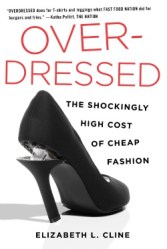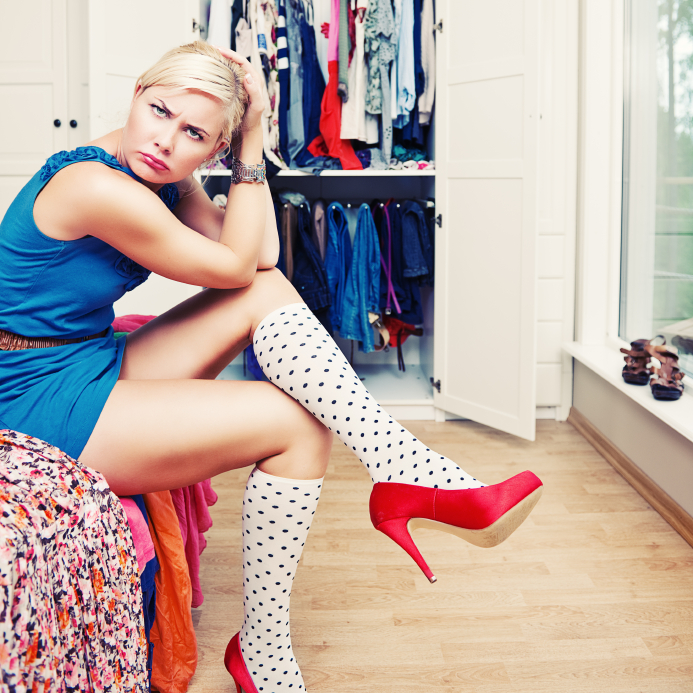
Off Target: Your money goes further when you spend it on quality products — and it’s more satisfying, too.
I really thought I was above binge shopping. But on a recent trip to Target, the women’s clothing section quickly pulled me in with trendy pastels, $19 dresses. The moments clawing through racks under fluorescent lights are a blur — but unfortunately, the resulting bright purple shorts are all too real. They remain at the bottom of my closet, a (literally) uncomfortable reminder of the irresistible pull of cheap fashion.
Ring a bell? It’s no accident. The fashion industry has sped up and priced down to the point where a common shopping trip can make you feel like you’ve doubled down on a Double Down: bloated, unsatisfied, and foolish for indulging in something so trendy and cheap.
Elizabeth Cline was all-too-familiar with the feeling. “I had gotten to a point where I really wouldn’t buy any clothing if it was over $30 and I owned almost 400 pieces of clothes as a result,” Cline says. The Brooklynite was curious as to how clothing had gotten so cheap and why it felt like her huge closet lacked substance and any sense of personal style.
So she set out on a nearly three-year journey behind the scenes of the fashion industry, traveling from sweatshops in China to overflowing Goodwills to a mostly shuttered New York garment district haunted by ghosts of U.S. industry’s past. The resulting book, Overdressed: The Shockingly High Cost of Cheap Fashion, is a revealing look at how fashion arrived at where it is today. Before you write off apparel as low-hanging Fruit of the Loom, keep in mind that clothing is easily the second largest consumer sector, after food. I chatted with Cline about how cheap clothing cramps our style, our economy, and our planet.

Elizabeth Cline. (Photo by Matt Roth.)
Q. How do companies make clothing so cheaply now?
A. The secret is in producing clothes at really high volumes. The product is cheap and low quality but they are able to take a very small markup on the clothes. The other ingredient is cheap labor in developing countries.
Q. How have prices changed over the last couple of decades?
A. Going back to the ‘50s and ‘60s, you could still walk into a department store and almost everything would be mid-priced, meaning you would find things — and this is adjusted for inflation — that were between $60 and $300. That’s what people were used to paying for ready-made clothes off the rack. What we’ve seen over the last several decades is the industry splitting into two extremes. There are very few middle-market brands and retailers and everything has become very cheap or irrationally expensive on the other end. It’s interesting to me because it really has followed the decline of the middle class in the U.S. as well.
Q. I think the phrase you used was “recession brands.”
A. Now that we’re in the middle of a global economic downturn, it’s making people even cheaper. It’s a huge problem because one of the reasons why I think we’re in this economic crisis is because we don’t have a manufacturing base anymore. … The garment and textile trades were two of the fastest-dying industries of the last 10 years. Those are a lot of really crucial jobs that are just gone now. People don’t think about that when they’re in these stores buying $10 dresses.
Q. What are the environmental impacts of cheap clothing?
A.  The way I approached it in the book was to talk about the dramatic increase in our consumption because I think people infer what that means for the environment. One of the more astonishing figures from the book was that our fiber consumption has leapt from 10 million tons to 82 million tons [annually] in the last 60 years. It’s far outpacing population growth.
The way I approached it in the book was to talk about the dramatic increase in our consumption because I think people infer what that means for the environment. One of the more astonishing figures from the book was that our fiber consumption has leapt from 10 million tons to 82 million tons [annually] in the last 60 years. It’s far outpacing population growth.
I also get into the waste that’s created. We throw away 68 pounds of textiles per person per year. On top of that, we’re using thrift stores and charity shops as dumps for an incredible volume of clothes that we don’t wear anymore. [The average charity shop is able to sell a mere 20 percent of what comes in.]
Q. With the economy being what it is, how much do you think we’re going to be able to change if wages stay flat? I feel like we could run into the same problems as the food movement: It’s easy for the wealthy to buy with their conscience, but difficult for most people to make a big change.
A. I think it is similar to the food movement in that people in this country don’t have a lot of money yet they’re obese. It’s so similar to fashion. We are drowning in cheap clothes. Even people who don’t have a lot of money have overflowing closets. I think it’s about how people spend the money they do have. The national average of spending on clothing is around $1,100 per year. Instead of going out and buying another two pairs of jeans when you already own 10, think about using that money this year to instead invest in something that you’re going to keep for longer. Or invest in something that you don’t already own that’s actually really unique. I think it’s about changing the way you shop and not necessarily increasing your overall spending. …
In so many ways, in our lives and in this world right now, people are looking for ways to reconnect. And clothing is such a fundamental part of our culture, part of our economy, and part of our everyday lives that I think people are really going to embrace figuring out a different way to clothe themselves.
Q. I thought it was interesting that buying vintage isn’t the solution. It’s part of the solution, but there’s a limited number of pieces out there.
A. Right, if the whole world started shopping vintage tomorrow, by the end of the day it’d probably all be dried up.
Q. We’d all look really cool for a little bit, though.
A. Yeah, at least we wouldn’t all be wearing acrylic and polyester. [Synthetic fibers are now 63 percent of the global output.]
Q. What’s the best way to make a difference?
A. Support local and independent fashion designers when you can, and that includes people who are using sustainable fabrics but also people who make their clothes domestically. Support fair trade clothing and living wage clothing when you can. …
In terms of online resources, there’s this newer site called Fashioningchange.com. You input what brands and stores you shop at now and it gives you a comparable alternative that’s sustainable. [Editor’s note: Oh my god.] …
Also, ask yourself, “Do I really need another tank top, pair of jeans, pair of shoes?” Look at what you already own and take care of it. I’ve really gotten into using seamstresses and tailors and getting back into altering and customizing the things that I already own. I just think that that’s enormously satisfying and it really stops that obsession with needing something new. I think a lot of that comes out of the fact that everything in our closet is just a little bit off. So I think that it’s really cool to be able to go to a tailor and say, “Please take my pants in, take in the side seams, cut off this weird bow.” Whatever it is. Make it work for you.



